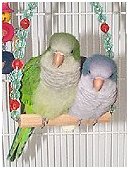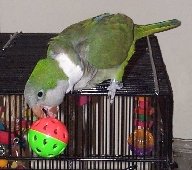There has been much discussion recently on the topic of feather plucking in companion parrots, along with even greater speculation on its possible causes. Companion bird owners who have watched their beloved and well-cared for parrots pluck themselves bald, as well as the veterinarians who have attempted to treat these birds, have come to the unfortunate conclusion that rarely is there a single definitive cause for feather plucking, making a “blanket cure” for any birds falling into this category virtually impossible. For the owners new to plucking and mutilation syndromes, this is a heart-wrenching and devastating discovery.
One quaker owner recently wrote:
“Her plucking has been worse lately. I am so scared it could escalate into mutilation. Lately she has been pulling and letting out that little scream like they do when you touch the wrong pinfeather, then she goes right on and does it again, so now she’s plucking even if it HURTS..and I have seen several small spots of blood on her crop and under her wings. Feathers not plucked are chewed. There isn’t any way to give her more attention, unless we stay up all night together too. And I know they say you can give the problem too much attention, which I may be guilty of. She was sitting in her cage last night saying, ‘Plucking? Plucking your feathers? Your pretty feathers? Poor baby bird…’.”
“Right now I’m trying the mirror, a humidifier, a negative ionizer to clean the air, daily baths, and chicken meat in her diet several times a week. I’ve already tried more attention, bigger cage, aloe vera, various ‘plucker’ toys, etc,etc. I’ll let you know if any of this stuff ever works. I might consider getting her a friend, but as near as I can tell, she hates other birds. Right now she’s in this endless moult and also very nippy and touchy, last night she bit my oldest son while he was sharing his food with her………..”
Quaker Mutilation Syndrome, 
Quakers who suffer from QMS not only pluck and/or mutilate their feathers; they mutilate their own flesh to a devastating, and sometimes fatal, degree. Target areas appear to be the flesh on the chest, under the wings, and the thighs; many cases have been reported that involve other areas as well. And while feather plucking is a serious problem in itself, QMS can potentially result in severe scarring, physical handicaps and debilitation, or even death.
It has only been in the last few years that QMS has been given its definitive name. I don’t think that QMS is a new problem, but rather an identified result of an ever-increasing number of quaker parrots kept as companion birds. While plucking and mutilation have been observed in all species of captive parrots, it appears that an increased number of incidents have been noted in those species which have exhibited a higher intelligence, such as the African Grey parrots and members of the Cockatoo family. The addition of the quaker parrot to the class of “prone-to-plucking” species seems to follow a logical train of thought; quakers are becoming quite well-known for their intelligence and talking ability. Their popularity as companion parrots is at an all-time high, and with the unveiling of recent new color mutations their desirability is only expected to increase.
Feather plucking and/or mutilation in and of themselves are not diseases; but indicators of an underlying problem. This definition, in turn, has resulted not only in frantic brainstorming in an attempt to identify those underlying causes in order to design, for each individual cause, a potentially effective treatment or cure; but also in the question of which problem came first: Are these birds plucking/mutilating as a result of a psychological cause? Or is the plucking/mutilation a psychologically maladaptive attempt to deal with an underlying physical problem?
Feather plucking, biting (snipping the feather shaft at the base, where it emerges from the skin), and feather/skin mutilation are all designated as behavioral problems, and are seen only in the captive bird population. Feather care behavior is crucial to the survival of birds in the wild. Feathers have many functions aside from their obvious contribution to flight: They are intimately involved in the regulation of body temperature, protection from the elements and in courtship displays. In captivity, some of these roles aren’t quite as critical to a bird’s survival.
Yet classifying plucking and/or mutilation as a “behavioral” problem is a generalization that can be confusing to some, since most common “behavioral” problems are the result of an owners inability to correctly read their bird’s body language and provide for his/her needs accordingly, or the result of the owners unknowingly reinforcing their bird’s negative behaviors. 99% of the plucking/mutilation cases I have discussed or viewed first-hand have most definitely not been the result of any negligence or ignorance on the part of the owner/s, which makes them all the more puzzling. The cases I have seen have involved birds whose owners have provided them a varied, complete diet; lots of toys that are rotated frequently and routinely; plenty of TLC; roomy cages with frequent time out of it; a definite flock order and loving, nurturing guidance beginning in their early formative stages. All medical causes have been ruled out. Yet these very same birds will pluck and mutilate themselves until they bleed profusely.

Gator was the only quaker out of a clutch of five that I am aware of that plucks. His parents are wild-caught quakers that were purchased from a well-known aviary in Florida several years ago. The parents are not pluckers, nor have they ever, during the 8 productive years that we have owned them, produced any other chick that suffered from QMS.
QMS is especially horrifying for an owner to witness, and often evokes deep feelings of guilt even though the owner is obviously not at fault. While I myself have been fortunate enough not to have experienced such a tragedy, I have continually heard stories of quakers who have mutilated their flesh to such an extent that their muscles and tendons were exposed; and after emergency trips to the veterinarian to stitch up the damage, proceeded to rip open those stitches within seconds and continue to further mutilate their own flesh. To the desperate and heartsick owners of these quakers who have spent countless hours searching for any possible explanation for this self-destructive behavior, the question remains:
WHY?
As with plucking, the causes of self-mutilation can be multiple, and each one can be interwoven with still others, making definitive causes impossible to detect. For instance, a broad-spectrum diagnosis of “pruritis” (itchy skin) is quite common in some cases of feather plucking and mutilation, yet further investigation is required in an attempt to identify the cause of “itchy skin”. At the very root, most causes will fall into two general categories: medical and non-medical (psychological).
Medical Causes Could Include:
- Endocrine diseases such as low thyroid levels, progesterone or testosterone imbalances, diabetes
- Bacterial-related feather disorders such as bacterial sinusitis, feather folliculitis, Chlamydia
- Virus-related/feather disorders such as PBFD, PDD, French molt, Psittacine pox, canary pox
- Skin and/or feather infections
- Fungal diseases
- Internal organ diseases (Quakers are prone to Fatty Liver Disease)
- Internal parasites such as roundworms and tapeworm
- Internal tumors or kidney disease may cause birds to pluck diseased area
- Intestinal, respiratory, or crop infection could result in a hyper-sensitive reaction, which in turn leads to pruritis
- Nutritional deficiencies or food allergies
- Hormonal imbalances
- Guardia
- Simple dry, flaky, itchy skin (or the itchy skin could be a secondary result of a medical cause listed above)
- Ingested allergens, such as:
- Certain proteins
- Carbohydrates
- Chemical additives (preservatives, colors, or flavors)
- Inhaled allergens, such as:
- Smoke
- Cockatoo dander
- Perfumes
- House deodorants
- Pollen
- Dust mold
- Contact allergens, such as:
- Laundry detergents
- Deodorants
- Perfume
- Hair products
- Litter or nest box material
- Newspaper ink
*Note: As of this writing (December 25, 1997), it has been reported that the newest Avian Journal mentioned discovery of an unknown organism present in QMS afflicted birds. More research is under way to isolate the organism.
Potential Treatments
Obviously, the sheer number of possible medical causes is overwhelming, and makes pinpointing or ruling out any particular one (let alone a number of them) a painstaking and frustrating process. Hopefully you already have a veterinarian who is avian-certified and has an extensive background working with avian species. Tests can be conducted that can identify most of the medical conditions listed above, and other possible causes (such as allergens) can be identified through the process of elimination.
Your veterinarian should conduct a complete physical exam, looking for lumps, injuries, feather cysts, lipomas or other tumors. Diagnostic tests should, at a minimum, include a CBC (Complete Blood Count) and blood chemistry panels. Tests should be run for parasitic, yeast, fungal, and bacterial infections, as well as for psittacosis, Psittacine Beak and Feather Disease, and Guardia. Other tests may include radiographs or a skin biopsy. For a more in-depth look at tests that should be included in an exam along with explanations of their meaning and importance, please read “The Annual Well Bird Exam”, by Lisa Paul, D.V.M.
Meeting nutritional requirements is vitally important in any avian species, since deficiencies can sometimes lead to plucking. Quaker owners face an especially daunting task here. While quakers are classified as “parakeets”, there are traits specific to them; individualized and separate from those birds that are normally thought of as “parakeets”. One veterinarian stated that the nutritional requirements of a quaker most closely matched those of a cockatiel, while another stated that food designed for “small parrots” (i.e, Conures, Senegals, etc.) would be more beneficial.
At any rate, providing good nutrition is imperative, and often a particular food can provide entertainment value as well. Raw carrots, green beans, spinach leaves, peas in the pod, corn on the cob, apples, bread sticks, wheat toast, zucchini sticks, mini bagels, and mini rice cakes are easily shredded and may provide an alternative to plucking. (Similarly, toys manufactured with 100% cotton rope or sisal rope may alleviate or reduce incidents of plucking).
Angela Lennox, DVM, is a very knowledgeable avian veterinarian who has taken an interest in QMS, and has treated several quakers suffering from this syndrome. Mrs. Lennox stated that although there will never be one definitive cause for QMS, she has found that most cases are related to some type of medical cause as opposed to psychological. Many of the quakers she has treated for QMS have been found to have some type of nutritional deficiency, most notably Fatty Liver Disease resulting from all-seed diets. Another frequent medical cause appears to be mega bacteria and yeast infections. While Mrs. Lennox agrees that plucking and mutilation in other species, such as the African Grey and Cockatoo families, can often be a result of psychological causes, she believes that this is rare in cases of QMS.
Several treatments exist for allergic skin and feather diseases. The first is to identify the source of the allergy and remove it. The second is to medically manage the problem by treating the signs of the allergies with antihistamines or steroids. Once the allergens are identified, desensitization programs attempt to reduce the bird’s reaction to the offending antigens. The vet may administer a series of subcutaneous injections over a four-to-eight week period.
Hormonal imbalances are another oft-cited cause for feather plucking/mutilation. Unfortunately the most often heard response to this is, “Put the bird in a breeding situation”. Needless to say, this is not always an effective, nor feasible solution.
Some veterinarians will prescribe different drugs in an attempt to treat plucking/mutilation syndromes. Progesterone injections, testosterone, Human Chorionic Gonadotropin (HCG), Haloperidol (haldol), and Prozac are some of the common suggestions. However, as with any treatment, there simply isn’t a specific one that is going to be effective in all cases. Many times the drugs are only effective for a short time, if at all; and many owners have no desire to put their birds on antipsychotic drugs.
It is imperative that birds have the opportunity to bathe frequently, particularly in the colder, dryer seasons. Artificial heating tends to dry the air significantly, and in turn dries out skin rather quickly. Also investing in an inexpensive filter for your main water faucet may be useful in filtering out undesirable additives such as chlorine.
Making diagnosis even more difficult is the fact that many of these causes can also be effects of feather plucking or mutilation, creating a vicious cycle that could prove almost impossible to break. For instance, some types of skin (bacterial) infections may be a result of the mutilation to the skin, as opposed to the cause. Additionally, the plucking/mutilation can quickly and easily become a habit, and may continue even after the original root cause is found and treated effectively. In this case, the plucking/mutilation has simply “cycled” into a true behavioral problem….. resulting in a whole new set of questions.


Thank you so very much for such an informative article. I’m bring my 3 year old quaker to Lonely Grey Rescue Sanctuary in NJ tomorrow. It’s Bern over a year of her mutilating her feet. I’ve done everything suggested in this article.
Most difficult were emergency room visits that could happen @ anytime.
My heart is killing me but the Sanctuary told me that he has had success in breaking this habit. Seems the quakers are put in a vest where thay can move freely & yet not get at their feet. I had no idea quakers are prone to this behavior. I thought this was totally my fault. Decades ago I had a Quaker and he never picked. He past from a neurological disorder. I owe it to my beautiful bird to do whatever I can to help her out of this brutal situation.